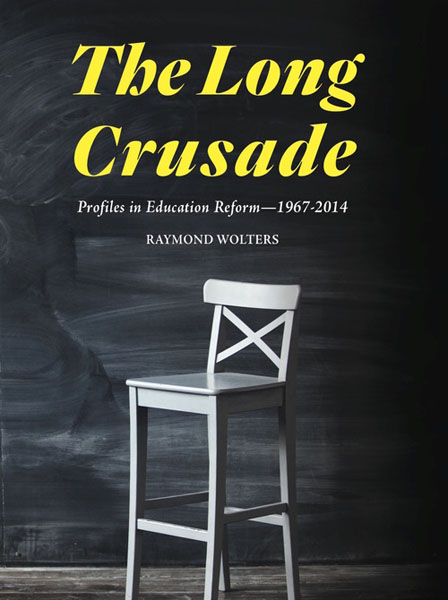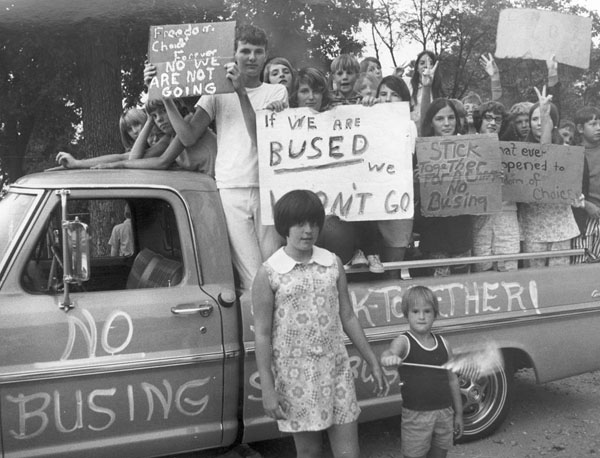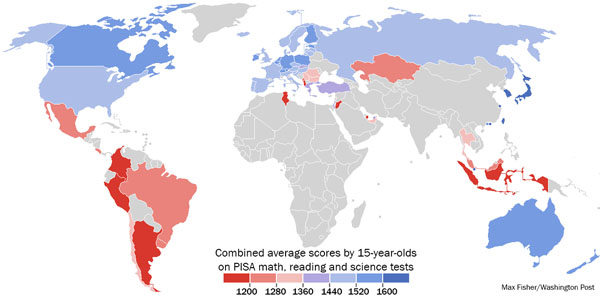The Egalitarian Illusion
Jane Weir, American Renaissance, August 28, 2015
Raymond Wolters, The Long Crusade: Profiles in Educational Reform–1967-2014, Washington Summit Publishers, 2015, 595 pp., $32.00 (softcover)
“It’s the biggest train set a boy ever had!” Orson Welles is reported to have said in 1940, upon arriving at a Hollywood soundstage to make Citizen Kane.
I don’t know if the Welles line is apocryphal, but it kept going through my head as I was reading The Long Crusade, Raymond Wolters’s masterful, comprehensive survey of progressive education fads and fallacies of the past half-century or so. A public education system is a huge and expensive train set–and one you cannot shut down. And so there’s endless opportunity for politicians, social engineers, and preening philanthropists to experiment: Chris Whittle’s Edison Project, Wendy Kopp’s Teach for America (and its many spinoffs), charter schools, magnet schools, universal Pre-K, No Child Left Behind, Common Core, etc.
The common thread running through most of these experiments is a preoccupation with race, or more specifically with the presumed needs of poor and “culturally deprived” black children. The fundamental questions never seem to change. How do we close the gap between black and white students? How do we make poor black children willing to learn and behave themselves in the classroom? And finally: How do we manage and teach our disadvantaged minorities without acknowledging the basic reality of racial differences in IQ?
As Prof. Wolters, emeritus professor at University of Delaware, explains in his introduction, this preoccupation with black uplift had its origins in the U.S. Supreme Court’s 1954 Brown v. Board of Education decision, but did not really gather steam until the Green v. New Kent County ruling in 1968. The Brown ruling abolished statutory segregation in public schools, but it did not mandate busing to ensure “racial balance.” Forced integration resulted from Green and later rulings.
In 2007, the Supreme Court finally quashed the notion of forced busing, but by that time the damage had long been done. The question was no longer how do we integrate public schools, but rather: How do we repair our miserable public schools, particularly those from which all whites have fled and are left only with poor black and brown children? Should we replace them entirely with semi-privatized school systems, or should we focus on getting rid of incompetent, unionized, teachers? Should we have a federally mandated curriculum? Out of such questions were born the endless fads and expensive gimmicks that have been forced onto our public schools.
This cry for school reform often includes misleading statistical claims. Who hasn’t heard the cliché that American children are far behind Children of Other Lands in reading, math and science? The PISA (Programme for International Student Assessment) scores prove it. This makes for a great wake-up call.
But it isn’t true. Prof. Wolters notes that if you disaggregate American test scores by race (p. 540):
There is simply not much improvement to be made. Our Asians are as good as Asia’s Asians–actually, better than Koreans or Japanese. Our white kids beat everyone else’s white kids except Finland’s. Our Hispanics outscored all eight Latin American countries. Our black kids trounced Trinidad, the blackest nation on the PISA list.
Prof. Wolters notes that the problem is not schools. It is increasing numbers of low-scoring blacks and Hispanics who are dragging down our scores in international comparisons.
Because of his encyclopedic knowledge and the span of time he covers, Prof. Wolters shows how certain educational and sociological theories pass in, out, and back into vogue. For example, recent years have seen the revival of what he calls the “inadequate mother thesis” to explain the black/white learning gap. This gap starts in kindergarten and even earlier because, according to the thesis, poor black mothers are not nurturing. They are hostile, abusive, and don’t read to their children. And so the children start school with small vocabularies and big behavior problems.
This “inadequate mother” idea was popular in the 1960s, but quickly fell out of favor because it suggested that black families suffer from some kind of social pathology. Daniel Patrick Moynihan’s 1965 Report on the Negro Family, which worried about high black rates of illegitimacy (25 percent at the time; 72 percent now) and absentee fathers, was attacked for the same reason.
But, as Prof. Wolters himself wrote last year, the theory has made a smashing comeback through the writings of University of Michigan psychologist Richard E. Nisbett (particularly in Intelligence and How to Get It, published 2009). Prof. Nisbett does not believe genetics have much effect on IQ. Instead, he argues that family behavior greatly influences intelligence, and that black families are often dysfunctional.
As Prof. Wolters wrote, “Prof. Nisbett expected to be criticized for resurrecting the social pathology rationale in the 21st century . . . [b]ut such criticism barely surfaced . . . .” In fact Prof. Nisbett’s theories helped push the idea of putting black children into Head Start while they are still in diapers.
History and analysis
The Long Crusade can be divided roughly into three parts. There is historical background that includes “neo-progressive” reformers of the 1940s-70s, including Theodore Sizer, Howard Gardner, and Jonathan Kozol. Despite the subtitle, the book’s historical perspective goes back well before 1967.
Then, there is a vast middle section of nearly 300 pages that describes the theories and nostrums of the past 35 years. This section is rich in detail and will be useful social historians. The average reader may find it tedious, but this is not Prof. Wolters’s fault. The education-reform theories themselves are similar and repetitive.
The most engrossing section is the last few chapters, in which we meet the critics of education reform. On the left there is education historian Diane Ravitch, a sort of neo-liberal who deplores the demoralizing effect that some reforms have had on public schools, and wishes we could return to the days of forced integration and court-ordered busing. On the right are the “race realists”–writers and academics who talk about IQ and evolutionary biology, and dare to point out the obvious.
These include molecular biologist James A. Watson; researcher Jason Richwine; anthropologist Henry Harpending of The 10,000 Year Explosion; and evolutionary biologist (and insect novelist) E. O. Wilson. We are also treated to the strange, surprising adventures of John Derbyshire, controversialist (We Are Doomed) and sometime mathematician, who was evicted from National Review Online in April 2012 after he published a satirical, race-critical essay called “The Talk: Nonblack Version.”
Robert Weissberg, who can also be called a race realist, gets a chapter of his own, which describes his theory that if schools are bad, it’s usually because the students are bad. Prof. Wolters praises Prof. Weissberg’s 2010 book Bad Students, Not Bad Schools (Wolters, pp. 552-553):
With a combination of erudition and wit that is rare in scholarly analyses of public policy, Weissberg said ‘what everybody (or nearly everybody) knows to be true but is fearful of expressing in public–America’s educational woes just reflect our current demographic mix of students.’ [Wolters quotes Weissberg]
Prof. Wolters concludes with a summary of his analysis, and explains how his own views evolved:
The false narrative is that American schools are failing. I subscribed to this view at one time. I began to rethink this assumption when I learned that very poor immigrant students from China, Korea, Russia, and Vietnam have done well in America’s inner-city schools. (Wolters p. 571)
And further:
As egalitarianism became a pervasive orthodoxy, school reformers doubled down on their commitment to abolishing racial and ethnic achievement gaps. Instead of acknowledging that even capable teachers would fail if students were not motivated or lacked an aptitude for school work, reformers insisted that things would be better if the American educational system were re-fashioned. (p. 575)
Controversy
Prof. Wolters has written at least seven books, two of them analyzing the effects of the Brown and Green decisions (The Burden of Brown, 1984; Race and Education, 1954-2007, 2009). As might be imagined, his evolving views have sometimes aroused hostility. Black historian Genna Rae McNeil did not care for The Burden of Brown:
Wolters does not stress the variety of components of socioeconomic status such as distribution of wealth, material conditions, or the impact of racial and class oppression on access to opportunities within the society. Rather he immediately focuses on ‘illegitimate births among Negroes’ and single-parent homes . . . . He ends this paragraph with a sentence which barely hints that he is discussing persons rather than animals: ‘A new pattern of mating and breeding had emerged, one that is at odds with traditional moral standards.’ (Georgia Historical Quarterly, Spring 1986, p. 169)
In fact Prof. Wolters has spent much of his career studying black social and intellectual history, and approaches it with much care. His first book was Negroes and the Great Depression (1970), and more recently he wrote a study of W. E. B. Du Bois called Du Bois and His Rivals (2002). It would not be possible to write a realistic analysis of black and Hispanic school performance in a more restrained and carefully nuanced way. Prof. Wolters’s sin is against taboos, not against sensitivity or the truth.



















